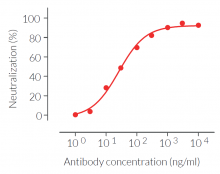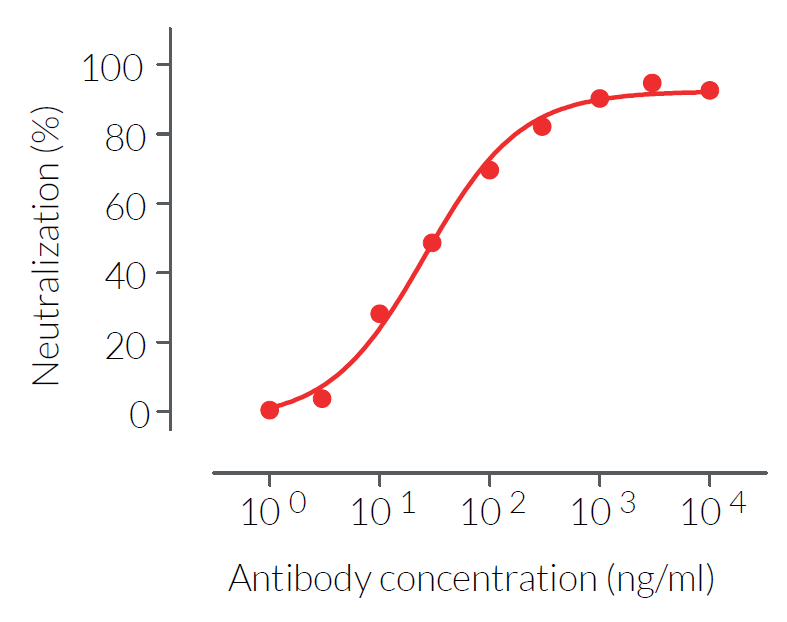Anti-hIL-33 Neutralizing mAb
| Product | Unit size | Cat. code | Docs. | Qty. | Price | |
|---|---|---|---|---|---|---|
|
Anti-hIL-33-IgG Human IL-33 Neutralizing Antibody (clone 19G8) - Monoclonal Mouse IgG1 |
Show product |
3 x 100 µg |
mabg-hil33-3
|
|
Neutralizing monoclonal antibody against human interleukin 33

Neutralizing monoclonal antibody against human IL-33
Anti-hIL-33-IgG (clone 19G8) is a monoclonal antibody (mAb) specific for human interleukin 33 (hIL-33). It is produced in hybridomas and purified by affinity chromatography. This antibody has been selected for its ability to efficiently neutralize the biological activity of hIL-33. IL-33 is a pro-inflammatory cytokine that shares structural and functional characteristics with the IL-1 cytokine family. It binds and signals through the IL-1RL1/ IL-1R accessory protein (IL-1RAcP) receptor activating NF-κB and MAP kinases.
Key features:
- A potent and specific neutralizing mAb against hIL-33
- Provided azide-free
- Each lot is functionally tested
References:
1. Arend W. et al., 2008. IL-1, IL-18, and IL-33 families of cytokines. Immunol Rev. 223:20-38.
2. Schiering C. et al., 2014. The alarmin IL-33 promotes regulatory T-cell function in the intestine. Nature. 513(7519):564-8.
Specifications
Target: Natural and recombinant human interleukin 33 (IL-33)
Clone: 19G8
Isotype: Mouse IgG1, kappa
Control: Mouse IgG1 Control
Immunogen: Human IL-33 protein expressed in Swiss mice following DNA immunization
Formulation: 0.2 µm filtered solution in a sodium phosphate buffer with glycine, saccharose, and stabilizing agents
Tested applications: Blocking & Neutralisation
Quality control:
- This product has been validated for neutralization.
- The absence of bacterial contamination (e.g. lipoproteins and endotoxins) has been confirmed using HEK-Blue™ TLR2 and HEK‑Blue™ TLR4 cells.
Contents
3 x 100 μg purified anti-hIL-33-IgG antibody, provided azide-free and lyophilized
![]() The product is shipped at room temperature.
The product is shipped at room temperature.
![]() Upon receipt, store lyophilized antibody at -20 °C.
Upon receipt, store lyophilized antibody at -20 °C.
![]() Reconstituted antibody is stable for 1 month at 4 °C and for 1 year at -20 °C.
Reconstituted antibody is stable for 1 month at 4 °C and for 1 year at -20 °C.
![]() Avoid repeated freeze-thaw cycles.
Avoid repeated freeze-thaw cycles.
Details
Interleukin-33 (IL-33; also known as IL-1F11) is a member of the IL-1 family, a group of cytokines that play important roles in host defense, immune regulation, and inflammation [1]. IL-33 mediates its biological effects through IL1RL1 (also known as ST2), a receptor expressed on Th2 and mast cells. IL-33 and IL1RL1 form a complex with IL-1R accessory protein (IL-1RAcP), a signaling receptor subunit that is also a member of the IL-1R complex. IL-33 signaling leads to the activation of NF-κB and MAP kinases.
IL-33 can function both as a traditional cytokine and as a nuclear factor regulating gene transcription. Following pro-inflammatory stimulation, Il-33 can induce Th2-biased immune responses, such as the production of IL-4, IL-5 and IL-13 [2]. In addition, as IL-33 is constitutively expressed in endothelial and epithelial cells, it can act as an endogenous danger signal, or damage-associated molecular pattern (DAMP; also called alarmins), in response to tissue damage [3, 4].
1. Arend W. et al., 2008. IL-1, IL-18, and IL-33 families of cytokines. Immunol Rev. 223:20-38.
2. Schiering C. et al., 2014. The alarmin IL-33 promotes regulatory T-cell function in the intestine. Nature. 513(7519):564-8.
3. Cayrol C. & Girard JP., 2014. IL-33: an alarmin cytokine with crucial roles in innate immunity, inflammation and allergy. Curr Opin Immunol. 31-7.
4. Oboki K. et al., 2011. IL-33 and airway inflammation. Allergy Asthma Immunol Res. 3(2): 81–88






